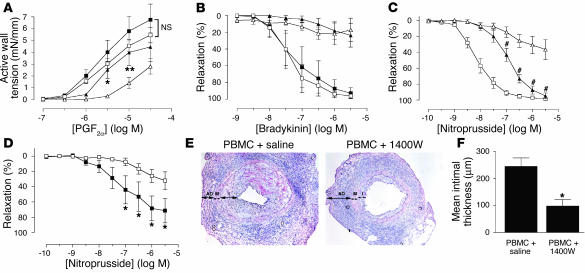Figure 5.
Contribution of iNOS to VSMC dysfunction and graft arteriosclerosis. (A–C) Arterial grafts recovered from animals at 2 weeks were exposed to the iNOS inhibitor 1400W ex vivo in the bath chamber (n = 3–6 pairs from four to five experiments). Concentration-dependent responses to PGF2α (A), bradykinin (B), and nitroprusside (C) of grafts from saline (squares) and PBMC (triangles) groups were measured before (open symbols) and after (filled symbols) treatment with 1400W. *P < 0.05; **P < 0.01; #P < 0.001 vs. PBMC group before 1400W treatment. Treatment with 1400W did not cause significant changes in any response of the arteries harvested from saline-treated animals. Saline group after 1400W treatment is not shown in the nitroprusside response. (D) Arterial grafts were recovered from mice reconstituted with PBMCs and injected daily with saline (open squares) or 1400W (filled squares) for 2 weeks (n = 5 pairs from three experiments). Smooth muscle function was assessed by the relaxation response of preconstricted arteries to various concentrations of nitroprusside. (E and F) Paired arterial grafts recovered from mice reconstituted with PBMCs and injected daily with saline or 1400W for 4 weeks (n = 6 pairs from three experiments). Morphometry of H&E-stained tissue sections (E), in which compartments are demarcated as adventitia (AD), media (M), and intima (I), was analyzed to calculate mean intimal thickness (F). Original magnification: ×200.

